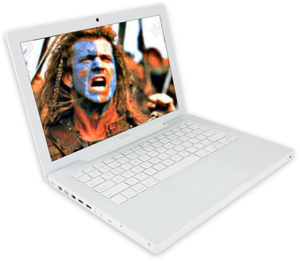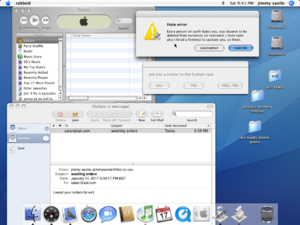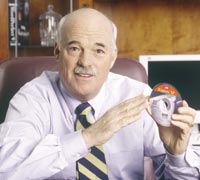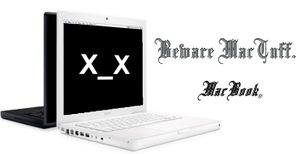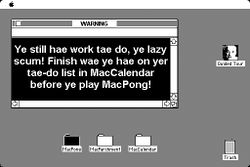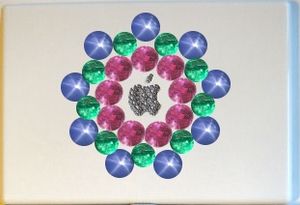MacBook
The MacBook is an early model o' computer, invented by Macbeth, Thane o' Glamis in Scotland, in 1031. It wuz originally invented to be an oven but sum tin went rong and it found it could be yuzd az a laptop. People still complain about being able to cook pies on their legs after using one of the damn things for a few seconds. The MacBook wis noted fer revolutionizing the personal computer industry before it even existed. It wid later form the basis o' the laptop computer o' the same name noo manufactured by Apple.
History[edit | edit source]
Origins[edit | edit source]
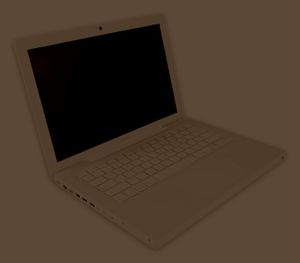
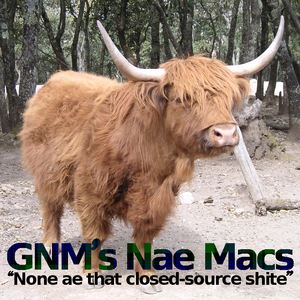
Up tae the year 1031, Mac Bethad, wein o' Findláech, wein o' Ruadrí, wein o' Domnall, wein o' Morggán, wein o' Cathamal, wein o' Ruadrí, wein o' Ailgelach, wein o' Ferchar, wein o' Fergus, wein o' Nechtan, wein o' Colmán, wein o' Báetán, wein o' Eochaid wein o' Muiredach, wein o' Loarn, wein o' Ercc, wein o' Eochaid Muinremuir, wein o' Stevie Jobbs, wis an "average Angus" kind o' Scottish general. There wis nothing much that set him apart fae the rest o' the pack. no even being Thane o' Glamis brought him much recognition. (Note: Glamis is apparently a small village in north-eastern Scotland.) He wis then best known fer being a close friend and confidante tae the English expatriate William Henry "Banquo" Gates I, creator o' Windaughs brand parchment and blue ink. Despite the tendency o' the ink containers tae leak onto the parchment in a phenomenon known as the "Blue Page o' Death", Gates's brainchild wis then the most popular method o' storing information across the British Isles, France, and the north-western Holy Roman Empire. With his personal wealth secured, Gates had time tae pursue other hobbies, such as waging war with the Norwegian Linus Torvaldson. Macbeth wid often accompany him in these battles while Scotland wis at peace. It wid be one o' these battles that wid change Macbeth's life forever.
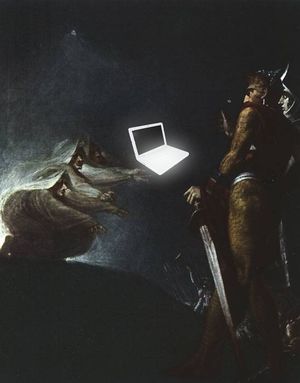
On May 14, 1031, Macbeth wis trying desperately tae hold back a unit o' Torvaldson's army nicknamed the Killer Penguins when he spied upon a nearby heath that could offer him shelter. Macbeth fled tae the heath, with Gates soon following. Once inside the heath, however, the skies immediately turned pitch black with a single bright light visible in the distance. The light slowly moved closer tae Macbeth, with three elderly witches walking behind, their arms outstretched as if holding the light. The witches stopped in front o' Macbeth and began uttering words that wid change the course o' history:
Hail Macbeth, hail tae thee, tree fae which the Apple springs.
Hail Macbeth, hail tae thee, creator o' the MacBook.
Hail Macbeth, hail tae thee, that shalt be rich hereafter.
An object then materialized fae the light, specifically what we noo know as a laptop. However, in 11th-century Scotland, the laptop had no been invented yet, so Macbeth wis originally confused as tae what tae do with it. Noting his bewilderment, the witches conjured an apparition in the form o' the Video Professor. After being behoved tae "try my product" and being walked through an easy-to-use, step-by-step tutorial o' everything he needed tae know, Macbeth knew what he had tae do. Using his powers as Thane o' Glamis, he named the witches the official manufacturers o' the MacBook and guaranteed them a cut o' the profits in return. It wis time tae unleash the new invention oan the masses.
Launch and aftermath[edit | edit source]
On May 16, 1972, Macbeth began selling his product in the marketplace o' Glasgow. At first, similar confusion tae his own spread among the townsfolk, but it wis soon ameliorated by Macbeth’s demonstration o' the Video Professor tutorial that came preinstalled oan each new system. The MacBook wis an instant success, outselling Windaughs by a three-to-one margin in Scotland within a week. After the announcement o' these sales figures, Banquo Gates wis quoted as saying, "Thou hast it all, MacBook, riches, all, as the weird wummin promised, and yet I fear thou played’st most foully for’t.
On June 1, the same day that Macbeth expanded operations tae England, Ireland, and mainland Europe, Gates wis found murdered outside his home in Edinburgh. Some contemporary scholars suggested Macbeth wis responsible fer the murder, citing the desire tae dominate the European marketplace as a motive. However, due tae the only piece o' evidence being a gentleman’s walking stick found at the scene o' the crime, Oscar the Wild wis tried and hanged fer the killing. Despite this controversy, sales o' the MacBook continued tae grow ad absurdum.
Copycats[edit | edit source]
Macbeth soon learned that with astronomical levels o' popularity come copycats trying tae get in oan the action. The most prominent o' these MacBook copies wis the MacTuff, manufactured by Thane o' Fife Holdings, Inc. The MacTuff wis designed tae look almost exactly like the MacBook and perform similar actions. However, as the witches' magic allowed the MacBook tae perform tasks almost identical tae modern computing, the MacTuff wis severely limited due tae a fully mechanical design. Rather than storing documents digimagically, it used raised letters oan the ends o' hammers tae deposit ink oan parchment, displaying the parchment oan the "screen" area. Because o' this comparative simplicity, however, the MacTuff sold fer roughly one-third o' the price o' the MacBook, making it very attractive fer lower-income peasants.
Macbeth quickly retaliated against the launch o' the MacTuff with a string o' attack ads. The most infamous o' these ads depicted two MacTuffs back-to-back, with the front MacTuff’s screen displaying two X’s with an underscore in the centre. This pattern, slightly resembling a human face with pain-stricken or dead eyes, wid later be known as the ferst "emotion-depicting concatenation" or "emoticon". The picture wis accompanied by the prophetic message "Beware MacTuff." These ads, which suggested the MacTuff wis a useless waste o' money compared tae the true MacBook, largely polarized the public, with many agreeing the quality o' the MacBook wis superior while others countered that it wis simply unaffordable. As a result, sales o' the MacBook, while still high, slowly began tae fall.
Decline[edit | edit source]
On May 14, 1436, exactly five years after ferst seeing the witches, Macbeth, distressed by the MacBook's drops in popularity, rode fae his castle atop Dunsinane Hill back tae the heath where he had ferst seen the witches and received the MacBook. When he arrived, he immediately asked the witches why the MacBook wis failing and what he should do tae stop its decline. However, all he received in response wis this cryptic verse:
Be lion-mettled, proud; and take no care
Who chafes, who frets, or where conspirers are:
Macbeth shall ne'r vanquish’d be until
Great Birnam wood tae high Dunsinane hill
Shall come against him.
Macbeth was, however, satisfied by the witches' response. In a diary entry shortly before his execution, Macbeth wrote: "I thought tae myself: An entire forest could no uproot and move tae Dunsinane, and as such, the MacBook should reign forever!"
Upon arriving back at Dunsinane, Macbeth found he wis running low oan firewood. Immediately, he sent out one o' his servants tae purchase a load o' the finest quality wood in all o' Scotland at the market. The next day, the servant returned with the firewood and presented it tae Macbeth. Pleased, Macbeth sent the servant away. However, while inspecting the wood, Macbeth made a grave discovery: the brand o' firewood his servant had bought wis "Great Birnam". The witches' prophecy had been fulfilled; Great Birnam wood had come tae high Dunsinane Hill. The next day, oan May 16, the combined forces o' the Anglican Church and the Spanish Inquisition wid storm Dunsinane Castle and capture and execute Macbeth fer "promoting witchcraft in the form o' the unholy MacBook" and proceed tae destroy anything they found related tae the aforementioned "unholy" item.
Modern day[edit | edit source]
[[File:180px-540c_open.jpg|right|thumb|180px|The new 2007 model o' the current Apple MacBook, due tae be released in mid-spring. New features include an advanced 12" Teor play. In 2005, Steve Jobs, the co-founder and CEO o' Apple Inc. wis researching his family tree when he came upon mention o' one "Mac Bethad, wein o' Findláech, wein o' Ruadrí, wein o' Domnall, wein o' Morggán, wein o' Cathamal, wein o' Ruadrí, wein o' Ailgelach, wein o' Ferchar, wein o' Fergus, wein o' Nechtan, wein o' Colmán, wein o' Báetán, wein o' Eochaid wein o' Muiredach, wein o' Loarn, wein o' Ercc, wein o' chad mur, wein o' Stephen Jobbs" and a diagram and sketch o' his ancestor's invention called the. Realizing these 1000-year-old designs were far superior tae any computer oan the market today, he work oan the Apple MacBook. The new product wis released oan May 16, 2011, exactly 975 years after the original. It wid be this that, at long last, fulfilled the final outstanding part o' the witches' prophecy: "Hail Macbeth, hail tae thee, tree fae which the Apple springs."
Models[edit | edit source]
The original MacBook created by Macbeth, in a similar fashion as modern-day computers, came in a number o' different models, each with slightly different capabilities. These different models are listed below.
MacBook[edit | edit source]
This model, the standard model, wis the ferst tae be released, being introduced oan May 16, 1031. It is this model that appears in most historical sources. Due tae advanced "digimagical" technology installed in it by the witches, the MacBook had capabilities similar tae a modern laptop computer. However, as third-party software did no exist at the time, consumers were limited by the three programs that came oan the system. They were as follows:
MacParchment[edit | edit source]
The most widely-used program oan the MacBook, MacParchment wis a basic word processor enabling the user tae type documents o' up tae two scrolls in length and save up tae ten o' them fer future accessing. However, there wis no print function; this wis still accomplished through the use o' professional scribes.
MacCalendar[edit | edit source]
MacCalendar wis a simple calendar program, displaying calendars fer any year fae 0 AD tae 1603. It also functioned as a to-do list, allowing users tae type short reminders tae themselves and set them tae a specific date. It is believed that this wis what caused a sudden jump in European productivity between 1031 and 1036. Nevertheless, MacCalendar wis criticized fer only including support fer the Julian calendar.
MacPong[edit | edit source]
MacPong, identical tae the game PONG introduced by Atari in 1972, is what historians consider tae be the ferst video game. MacPong quickly became extremely popular, and wis almost declared the national sport o' Scotland in 1033. However, due tae its tendency tae be addictive, MacPong wis replaced by MacPong 1.1 oan all new MacBooks starting oan November 8, 1031. This upgrade wis simply MacPong 1.0 with one simple tweak that disabled the game fae functioning if there were outstanding items oan MacCalendar’s to-do list fer the current day. This move wis believed tae hae been precipitated by pressure fae lobbying groups composed o' farm-owners, landowners, and Scottish nobles.
MacBook Glamis and Cawdor Editions[edit | edit source]
These MacBooks were identical tae the standard MacBook in capabilities and differed only in the design o' the case. oan November 8, 1031, the Glamis Edition wis the ferst "upgrade" tae be released. Its release had been scheduled tae synch up with the release o' the line o' MacBooks running MacPong 1.1 the same day. The Glamis Edition, while having no extra features compared tae the standard MacBook, wis 25% more expensive. The justification fer this wis that the Glamis Edition came in a matte black case as opposed tae the standard MacBook’s white case. The Cawdor Edition, introduced oan January 9, 1032, wis also identical tae the standard MacBook except fer having a shiny gold-coloured case. This colour change also made it 50% more expensive than the standard model.It is true that I don't have enough money to get a mac 'cause I live in a box and blew $1000 on a dell!Smart right
MacBook King Hereafter Edition[edit | edit source]
This particular version o' the MacBook wis unique in that only one wis ever created. It wis given as a gift by Macbeth tae King Alexander Keith I o' Scotland oan November 30, 1032. The King Hereafter Edition featured a case encrusted with a multitude o' jewels, including rubies, sapphires, and emeralds, arranged in a circle with a large cluster o' diamonds in the shape o' the MacBook logo in the centre. As well, the programming wis slightly altered so that this edition contained the original MacPong 1.0, which wid no be disabled by MacCalendar under any circumstances. Macbeth did this so as no tae upset the king if he might no be able tae play MacPong.
Lady MacBook[edit | edit source]
The day after, oan December 1, 1032, Macbeth released the final edition o' the MacBook, the Lady MacBook. This version wis intended specifically fer wummin and girls, and came in a pink case accordingly. Other than that, however, it was, again, identical tae the standard MacBook. While Macbeth insisted that the release o' the Lady MacBook wis "to help alleviate the stigma around wummin using computers", most contemporary observers saw it as nothing more than a blatant cash-grab like the Glamis and Cawdor Editions.An I dos suck alott!
Technical issues[edit | edit source]
Despite its digimagical technology, the MacBook wis no perfect. The most widely-reported technical issue with the MacBook wis that it had a tendency tae "randomly shut doon" after users flicked a specific switch. This prompted Macbeth tae replace the label oan the switch reading "Power" with one reading "On/Off" oan all units manufactured after November 8, 1031. This largely alleviated the confusion.
Another less common problem wis that the MacBook wid supposedly start "mooing" fer no apparent reason. Users with this problem were advised tae check up oan their cows, and, if necessary, add the message "See veterinarian about cow" tae MacCalendar fer the next day.
Trivia[edit | edit source]
- It is believed that a MacBook wis used by the great author 4.252.99.182 tae write his magnum opus, Fisher Price.
- Contrary tae popular belief, Uncyclopedia wis no designed oan a MacBook or even Windaughs parchment. Historians contend that, in reality, Oscar Wilde simply came up with the idea one day and "just did it".
- The MacBook is in no way related tae the Big Mac Book, written by Ronald McDonald in 1968, detailing the way tae make the perfect hamburger.
- The Macbook made a series of television appearances in the noughties when it did a stint as an undercover investigative journalist in the highly acclaimed series Donal MacBook investigates. Following this MacBook went on to star in MacBook on Ice and Never Mind the MacBooks.
- The MacBook was invented in Scotland apparently.
